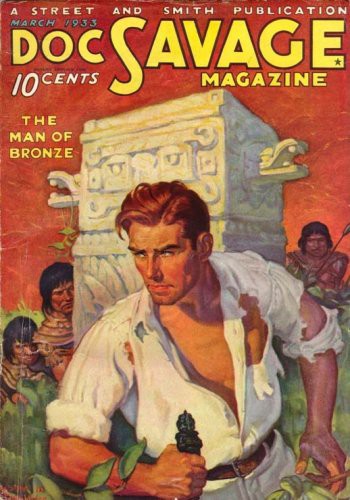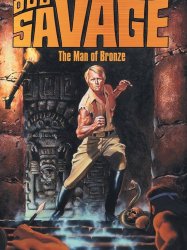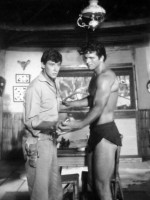Doc Savage

- Infos
- Photos
- Best films
If you like this character, let us know!
Real name Clark Savage, Jr., L'Homme de bronze
Doc Savage is a fictional character originally published in American pulp magazines during the 1930s and 1940s. He was created by publisher Henry W. Ralston and editor John L. Nanovic at Street & Smith Publications, with additional material contributed by the series' main writer, Lester Dent. The illustrations were by Walter Baumhofer, Paul Orban, Emery Clarke, Modest Stein, and Robert G.Harris
The heroic-adventure character would go on to appear in other media, including radio, film, and comic books, with his adventures reprinted for modern-day audiences in a series of paperback books. Into the 21st century, Doc Savage has remained a nostalgic icon in the U.S., referenced in novels and popular culture.
Biography
Doc Savage's real name was Clark Savage, Jr. He was a physician, surgeon, scientist, adventurer, inventor, explorer, researcher, and, as revealed in The Polar Treasure, a musician. A team of scientists assembled by his father deliberately trained his mind and body to near-superhuman abilities almost from birth, giving him great strength and endurance, a photographic memory, a mastery of the martial arts, and vast knowledge of the sciences. Doc is also a master of disguise and an excellent imitator of voices. "He rights wrongs and punishes evildoers." Dent described the hero as a mix of Sherlock Holmes' deductive abilities, Tarzan's outstanding physical abilities, Craig Kennedy's scientific education, and Abraham Lincoln's goodness. Dent described Doc Savage as manifesting "Christliness." Doc's character and world-view is displayed in his oath, which goes as follows:“
Let me strive every moment of my life to make myself better and better, to the best of my ability, that all may profit by it. Let me think of the right and lend all my assistance to those who need it, with no regard for anything but justice. Let me take what comes with a smile, without loss of courage. Let me be considerate of my country, of my fellow citizens and my associates in everything I say and do. Let me do right to all, and wrong no man.
”
Doc Savage's Aides
Savage is accompanied on his adventures by up to five other regular characters (referred to in the 1975 movie and in marketing materials from the Bantam Books republication as "The Fabulous Five"), all highly accomplished individuals in their own right.
Lieutenant Colonel Andrew Blodgett "Monk" Mayfair, an industrial chemist. Monk got his nickname from his simian build, notably his long arms, and his covering of red hair. He is in a constant state of "friendly feuding" with "Ham" Brooks. This began when his friend taught him some French words to say to an officer and Monk repeated them, not knowing they were a string of insults. The result was a lengthy stay in the guardhouse.
Brigadier General Theodore Marley "Ham" Brooks, an accomplished attorney. Ham was considered one of the best-dressed men in the world, and as part of his attire, carried a sword cane whose blade is dipped in a fast-acting anesthetic. His nickname was acquired when Monk, in retaliation for his guardhouse incarceration, framed Brooks on a charge of stealing hams from the commissary. In the only case which Ham ever lost, he was convicted of stealing the hams.
Colonel John "Renny" Renwick, a construction engineer. Renny was a giant of a man, with "fists like buckets of gristle and bone." His favorite pastime was knocking the panels out of heavy wooden doors. He always wore a look of depression, which deepened the happier he grew. His favourite - and frequently used - expression, was 'Holy Cow!'.
Major Thomas J. "Long Tom" Roberts, an electrical engineer. "Long Tom" got his nickname from using an antiquated cannon of that nickname in the successful defense of a French village in World War I. Long Tom was a sickly-looking character, but fought like a wildcat.
William Harper "Johnny" Littlejohn, an archaeologist and geologist. Johnny had an impressive vocabulary, never using a small word when a big one could suffice. ("I'll be superamalgamated!" was a favorite expression). Johnny wore eyeglasses with a magnifying lens over his left eye in early adventures (that eye having been damaged in World War I). Doc later performed corrective surgery that restored Johnny's sight in that eye, but Johnny retained the magnifier as a monocle for use both as a magnifying glass and as a memento.
In later stories, Doc's companions became less important to the plot as the stories focused more on Doc himself. At least one critic questioned their necessity since Savage's talents were superior to theirs and he often had to rescue them. The "missing" characters were explained as working elsewhere, too busy with their own accomplishments to help. Toward the end of the series, usually only Monk and Ham appeared with Doc.
Doc's cousin Patricia "Pat" Savage, who has Doc's bronze skin, golden eyes, and bronze hair, also was along for many of the adventures, despite Doc's best efforts to keep her away from danger. Pat chafes under these restrictions, or indeed any effort to protect her simply because she is female. She is also able to fluster Doc, even as she completely charms Monk and Ham.
The 86th Floor
Doc's office is on the 86th floor of a New York City skyscraper, implicitly the Empire State Building, reached by Doc's private high-speed elevator. Doc owns a fleet of cars, trucks, aircraft, and boats which he stores at a secret hangar on the Hudson River, under the name The Hidalgo Trading Company, which is linked to his office by a pneumatic-tube system nicknamed the "flea run." He sometimes retreats to his Fortress of Solitude in the Arctic – which pre-dates Superman's similar hideout of the same name. The entire operation is funded with gold from a Central American mine given to him by the local descendants of the Mayans in the first Doc Savage story. (Doc and his assistants learned the little-known Mayan language of this people at the same time, allowing them to communicate privately when others might be listening.)
Technology
Many futuristic devices are described in the series, some of which have since become reality, including the flying wing, the answering machine, television, automatic transmission, night vision goggles, electromagnetic rail guns, and a hand-held automatic weapon, known variously as the machine pistol, the supermachine pistol, or the rapid-firer. A wide range of ammunition types were used for the machine pistols, including incendiary bullets that smash on contact, coating the target with a high-temp paste-fed fire, high explosive bullets able to uproot trees, ordinary lead bullets, and the sleep-inducing "mercy bullets".
Villains
Doc's greatest foe, and the only enemy to appear in two of the original pulp stories, was the Russian-born John Sunlight, introduced in October 1938 in the Fortress of Solitude. Early villains in the "super-sagas" were fantastic schemers bent on ruling the world. Later, the magazine was retitled Doc Savage, Science Detective, and Doc dealt with more conventional criminal organizations. The super-saga was revived by a new editor shortly before the final cancellation of the magazine.
A key characteristic of the Doc Savage stories is that the threats, no matter how fantastic, usually have a rational explanation. For example, a giant mountain-walking spider is revealed as a blimp, a scorching death comes from super-charged electric batteries, a "sea angel" is a mechanical construct towed by a submarine, Navy ships sunk by a mysterious force are actually sabotaged, and so on. But Doc Savage also battles invisible killers, a murderous teleporter, and superscientific foes from the center of the Earth.
In earlier stories, some of the criminals captured by Doc receive "a delicate brain operation" to cure their criminal tendencies. These criminals return to society, unaware of their past, to lead productive lives. The operation is mentioned in Truman Capote's novel In Cold Blood, as an older Kansan recalls Doc's "fixing" of the criminals he had caught.
Played by the actor
Filmography of Doc Savage (1 films)
 , 1h52
, 1h52Directed by Michael Anderson
Origin USA
Genres Comedy, Action, Adventure
Themes Superhero films
Actors Ron Ely, Paul Gleason, Michael Berryman, William Lucking, Eldon Quick, Darrell Zwerling
Rating53%





Doc Savage (Ron Ely) returns to New York City following a visit to his Arctic hideaway, the Fortess of Solitude. He learns that his father has died under mysterious circumstances while exploring the remote interior of the Central American Republic of Hidalgo. While examining his father's personal papers, Doc finds himself the target of an assassination attempt. Doc Savage chases and corners the sniper on the nearby Eastern Cranmoor Building, but the would-be assassin loses his footing and falls to his death. Examining the body, Doc discovers that his assailant is a Native American with peculiar markings; his fingertips are red, as if dipped in blood, while his chest bears an elaborate tattoo of the ancient Mayan god Kukulcan. Returning to his penthouse headquarters, Doc finds that intruders have destroyed his father's personal papers. Vowing to solve his father's murder, Doc Savage flies to Hidalgo with "The Fabulous Five", his brain trust, at his side.
 Connection
Connection
